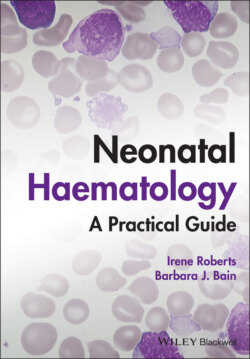Читать книгу Neonatal Haematology - Barbara J. Bain, Irene Roberts - Страница 28
Leucocyte production and function in the fetus and neonate
ОглавлениеAll of the same types of normal leucocyte found in older children can be seen in peripheral blood films of term and preterm neonates (Fig. 1.13), although their frequencies vary from those in older children and also vary both with gestational age and with postnatal age (see Table 1.2). Blast cells are the only cells commonly seen in neonatal blood films that are not usual in blood films from healthy older children or adults (Fig. 1.14).
Fig. 1.13 Blood film of a preterm neonate showing normal white cells – two neutrophils, an eosinophil and a monocyte. MGG, ×100.
Fig. 1.14 Blood film of a healthy preterm neonate born at 25 weeks’ gestation showing a neutrophil and a blast cell. MGG, ×100.
There is increasing recognition that leucocyte function in the fetus and newborn differs from that in adults95 and that this is almost certain to contribute to the increased susceptibility to infection in neonates, particularly in those that are extremely preterm.96 As the adaptive immune system only properly develops with antigen exposure after birth, neonates are specifically dependent on the innate immune system as a first line of defence against bacterial and fungal pathogens in particular.97 Remarkably, all of the cellular components of the innate immune system are established in the human fetus over a small number of weeks late in the first trimester and early second trimester of fetal life.16
